Of course, adriaticnature will provide information on tuna, sea bass, horse-mackerel, garfish and a lot of other fishes. We will even talk about the inhabitants of the sea depths that are not so popular. But we’ll start with one of the most extraordinary but at the same time traditional inhabitants of the Adriatic, that is, moray eels (muraenas).
The Muraenidae family belongs to eels, the Anguilliformes order, to be more precise. But in spite of the snake-shaped body of moray eels, similar to other representatives of Anguilliformes, a person that is fairly well aware of the subject will easily specify the species these fish belong to.
On the whole, the Muraenidae family includes 202 known species, united in 16 genera. The smallest moray eel, Snyder’s moray (Anarchias leucurus), inhabits the Pacific Ocean and is up to 11.5 centimeters long. The longest one is slender giant moray (Strophidon sathete). It inhabits the Red Sea and the waters near the shores of East Africa in the western part of the Pacific Ocean. Its length reaches 4 meters. The heaviest is considered to be a giant moray (Gymnothorax javanicus), that can be up to 3 meters long. It can weigh more than 30 kilograms. It inhabits the Indo-Pacific region as well.
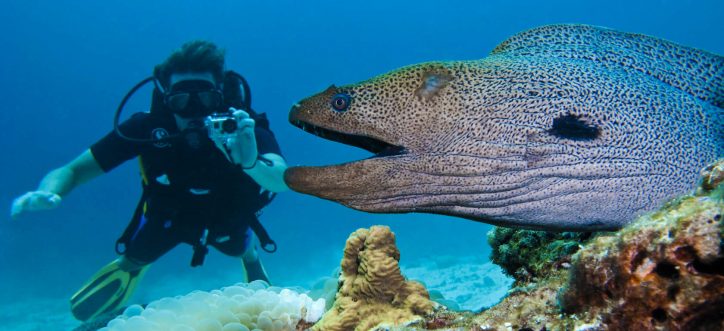
(Giant moray (Gymnothorax javanicus). Photo by © news.scubafish.com)
Moray eels are predators and feed mainly on small fish, octopus, squid, cuttlefish and crustaceans. They don’t disdain carrion.
Usually they swim 20-60 meters deep, but the European moray (Muraena helena), a permanent resident of the Adriatic, manages to descend to 800 meters deep.
Lurking predators, hiding in corals, crevices of rocks and caves of the seabed during the daytime, hunt at night and move from their shelters far away. They can swim near sandy or pebble beaches, places overgrown with submerged vegetation, over the muddy bottom – everywhere, in a word. Muraenas are suggested to have bad eyesight, which is balanced out by excellent olfaction.
Life duration of moray eels isn’t specified precisely, most species can live more than 10 years.
Moraenas spawn far from the coast, where they spawn up to 60,000 eggs, but their spawning is very poorly studied. Like all representatives of the Anguilliformes order, the development of moray eels passes through a special stage of larval development, that is, leptocephalus. Larvae of other fishes differ from leptocephaluses. Leptocephalus is completely transparent. It is strongly flattened on the sides. There are no red blood cells in the blood. Besides, there are other peculiar anatomical features. And this stage is durable.
When you look at rare videos that record the behavior of leptocephalus in nature, you can’t help but be surprised at the perfection and diversity of the surrounding world.
(Muraena leptocephalus at the early stage of development. Video by © Drs Julian Finn & Mark Norman. australianmuseum.net.au)
Transparency, gelatinous consistency and behavior of leptocephaluses remind of the ones the jellyfish, ctenophoran, siphonophore, and salp have. Due to stinging properties and low nutritional value, many fish avoid eating such zooplankton. This similarity provides leptocephalus with high chances of surviving, for which pelagic predators undoubtedly pose great threat.
(Muraena leptocephalus at the late stage of development. Video by © HRF U/W Production. australianmuseum.net.au)
The drift period lasts 6-10 months. This time is enough for leptocephalus to grow and start sedentary life, gaining flesh and color, and gradually these underwater beautiful “ghosts” turn to fish, which are well known to us live or in pictures.
The structure of the jaw apparatus is one of the most amazing and unique features of moray eels. The main jaws are equipped with strong muscle-clamps, and long sharp teeth are great for capturing prey. But the main peculiarity is the second pair of pharyngeal jaws. When the main jaws close, catching the trophy, the rear ones go forward and grab the prey by hook-shaped teeth and forcefully draw it into the pharynx. Muraenas are the only vertebrate animals, in which a similar phenomenon is found.
(The second jaw in action. Video by © Smithsonian Channel)
Other bony fishes have pharyngeal jaws too, but they are usually small and almost inactive and facilitate in swallowing or grinding up food. The suction technique is usually used for catching prey. They open the jaws abruptly and step up the volume of the mouth cavity, then create a powerful current of water, which carries the nearby prey, drawing it into the mouth of a predator. Muscles of moray eels, which set their pharyngeal jaws in motion, are much longer than in other fishes. In addition, they can stretch several times, which enables muraenas to move their jaws back and forth along the entire skull.
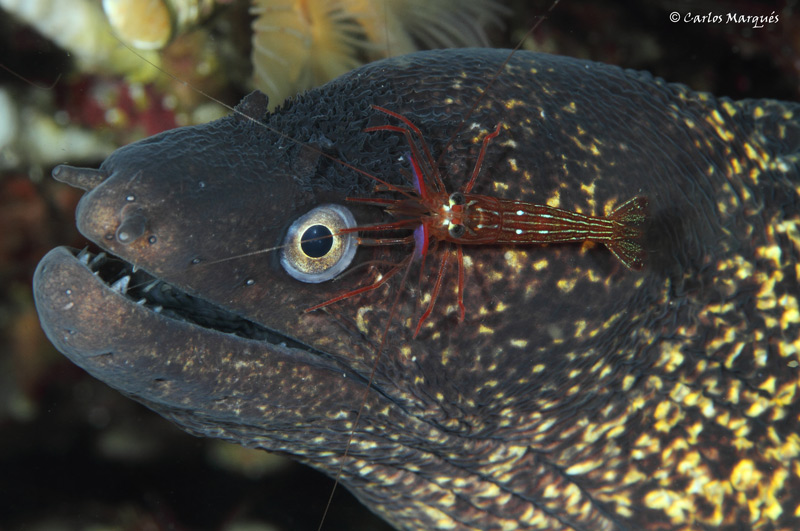
(Mediterranean moray (Muraena helena). Photo by © Carlos Marqués. fotonatura.org)
In the Adriatic Sea, there are three following kinds of moray eels: Mediterranean moray (Muraena helena),fangtooth moray (Enchelycore anatina) and brown moray (Gymnothorax unicolor).
Mediterranean morayis the most widely spread. It can be up to 1.5 meters long and weigh 6.5 kilograms. It often sticks to the coastal waters but can descend to 800-meter deep.
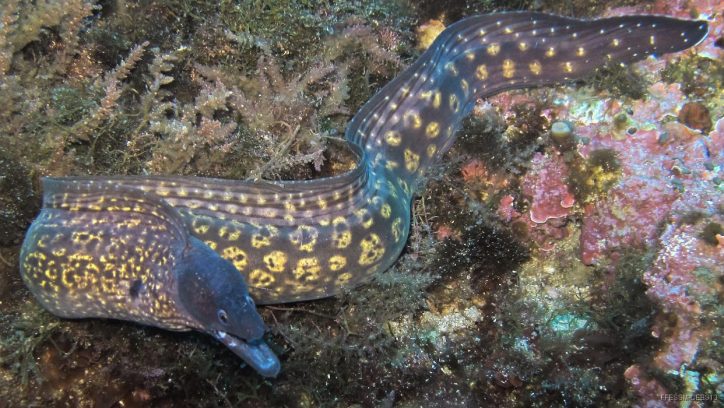
(Mediterranean moray (Muraena helena). Photo by © Sylvain le Bris. cebs13.free.fr)
Brown morayis a much more rarely found in the Adriatic Sea. It is a less common inhabitant of the seas, which is found in the eastern part of the Atlantic Ocean from southern Portugal to Cape Verde, including the Azores, Madeira and the Canary Islands, as well as throughout the Mediterranean. It is more often found in the southern part of the Adriatic, closer to the border with the Ionian Sea. It can be a meter long and weigh 6 kilograms.
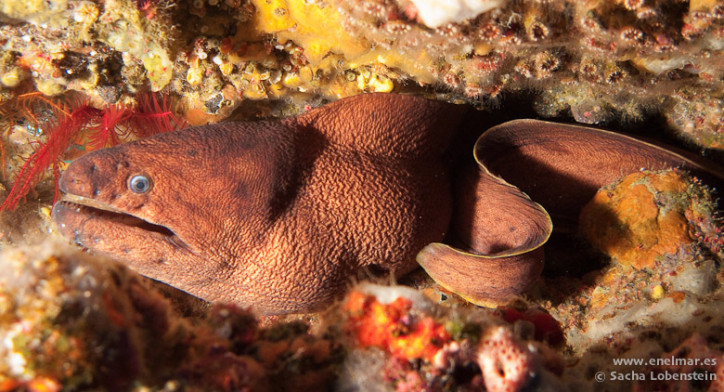
(Brown moray (Gymnothorax unicolor). Photo by © Sacha Lobenstein. enelmar.es)
And the least common inhabitant, which was not found in the Adriatic Sea until recently, is fangtooth moray. A species, which occurs on both sides of the Atlantic Ocean and was found near the African and Spanish coasts of the Mediterranean, has been recently discovered in the Adriatic. This beauty was registered to be found in 2010 near the Croatian island of Sušac for the first time. Fangtooth moray can be up to 120 cm long and weigh 5 kilograms.
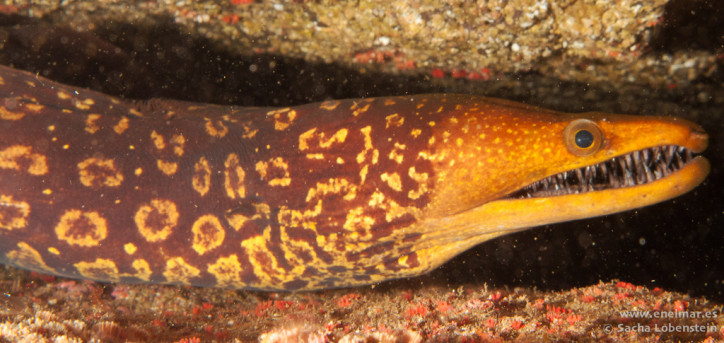
(Fangtooth moray (Enchelycore anatina). Photo by © Sacha Lobenstein. enelmar.es)
All three species of moray eels, inhabiting the Adriatic, pose a certain danger to fishers and underwater hunters. Near its habitation, as well as being withdrawn from the water, the moray eel can attack a troubled hapless hunter and bite painfully, inflicting unpleasant lacerated wounds. The major hazard is the microflora and toxins in the mouth and on the teeth of moray eels. Toxins can infect the wound and, in extreme cases, cause blood poisoning. Under the water, moray eels, in the vast majority of cases, prefer to recede, rather than behave aggressively against a human being.
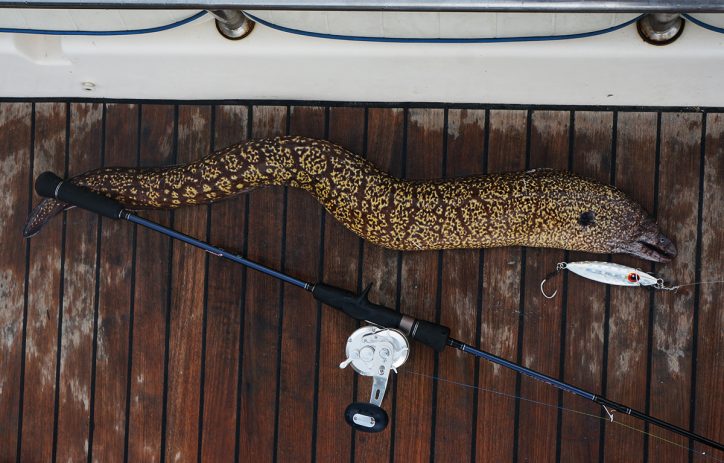
(Mediterranean moray (Muraena helena). Photo by © adriaticnature)
Catching Mediterranean moray is quite simple. adriaticnature will describe it in the article devoted to this issue and make the on-the-spot report, although catching a moray eel doesn’t seem to be a very exciting event to adriaticnature. However, despite the fact that the “catch-release” principle is welcomed by adriaticnature, eating qualities of moray eels are highly appreciated, and in case of catching moray eels, it’s almost impossible to adhere to this principle. Moreover, according to some sources, the ancient Romans considered the moray eel flesh to be a delicacy and they even learned to breed them in cages.
So hunting for beautiful, evil and aggressive predators will surely bring a lot of pleasure to the fans of bottom fishing, wishing to spend amazing pre-dawn, pre-dusk, or even night hours on the sea. Moreover, the gear, used to catch muraenas, can be used to catch other sea eels as well. adriaticnature will provide information about them in the next posting of the section.